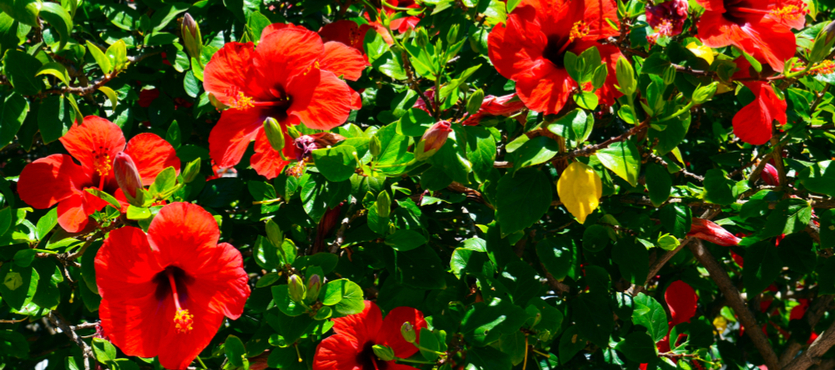Hibiscus is a beautiful flowering shrub that evokes dreams of exotic South Pacific Islands. Hibiscus rosa-sinensis or tropical hibiscus are those with which you are likely most familiar, though there are many native species in the United States. Believed to have originated in tropical regions of Asia, hibiscus flowers, single or double blossoms, come in a multitude of bright hues. And though individual hibiscus blooms only last for a single day, here in South Florida, the shrubs produce flowers year-round. If all that isn’t enough to make you love them, hibiscus flowers attract both hummingbirds and butterflies.
Hibiscus Varieties
Hibiscus come in a variety of sizes and shapes – from trees that can tower to twenty feet to low growing shrubs that are dense and compact, while others are open and flowing. Hibiscus blossoms offer up hues ranging from bright white to vivid pinks, yellows, reds, and even coral tones. They can be used successfully in landscapes, as foundational plants or background fillers, informal hedges, or planter beauties.
One of the most common in Florida is the marsh hibiscus, formally known as the Hibiscus coccineus, and commonly called the scarlet rose mallow. This beautiful perennial often grows to 8 feet tall or more and features striking red flowers. Because the marsh hibiscus is a native of the wetlands, it thrives along streams and around ponds, though it is also tolerant of drier soils if watered properly.
Caring for Your Hibiscus
Adding hibiscus to your garden brings bold and exotic flair. Whether you choose to add hibiscus directly to your garden or grow them in containers or both, here are some important tips you’ll want to apply to keep your hibiscus healthy and those stunning flowers blooming year-round.
Containers
If you choose to grow your hibiscus in containers, you can move them around, providing the plant with optimum conditions while you enjoy their beauty anywhere on your property. Keep in mind, when positioning your hibiscus containers, these plants needs lots of sunlight to bloom – a minimum of six hours daily. (This is also important to note when planting hibiscus directly into your landscaping.) Hibiscus love warm, humid conditions, a crucial fact should you move your potted hibiscus inside. In planters, hibiscus plants like a tight fit, meaning they grow best when somewhat root bound, and when it is time to repot, only size up your container slightly. Remember your potted hibiscus needs lots of water and exceptional drainage to thrive.
Hibiscus Thrive in Sunny Warmth with Lots of Water
As mentioned above, your hibiscus thrives in warm, humid conditions, preferable above 60 degrees F, which isn’t usually an issue in South Florida. While your hibiscus is blooming (nearly all year here in South Florida) they will need daily watering to keep blooming year round.
Fertilizing Your Hibiscus
Your hibiscus need nutrients to grow, bloom, and flourish all year long which means fertilizing is a must. Hibiscus need a high potassium fertilizer, which can be added in a number of ways. You can choose to apply fertilizer in diluted liquid form weekly, or monthly add slow release fertilizer or high potassium compost.
Hibiscus are fairly easy to maintain in containers or as part of your landscape, but should you need assistance or guidance along the way, the experts at Xtreme Landscaping are ready to come to your aid to help with your hibiscus or any of your landscaping needs.

